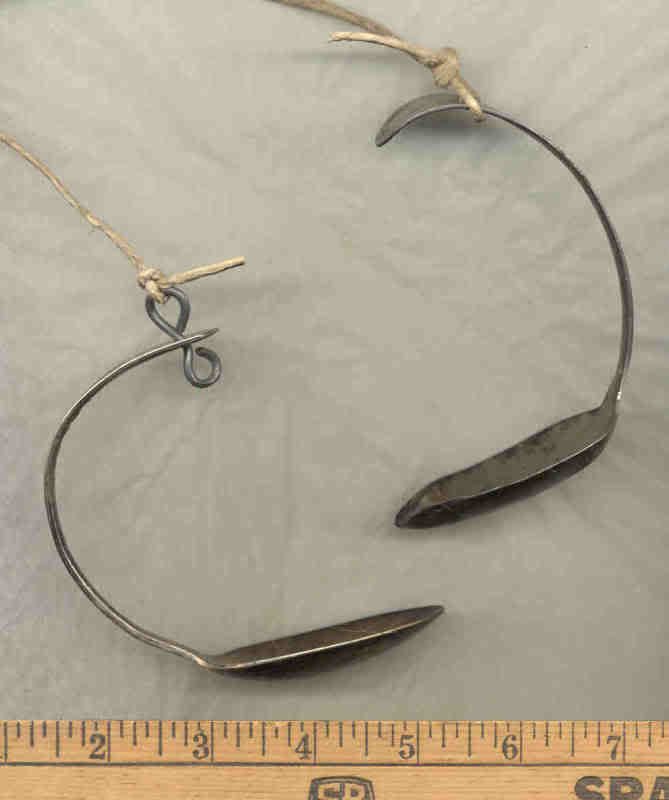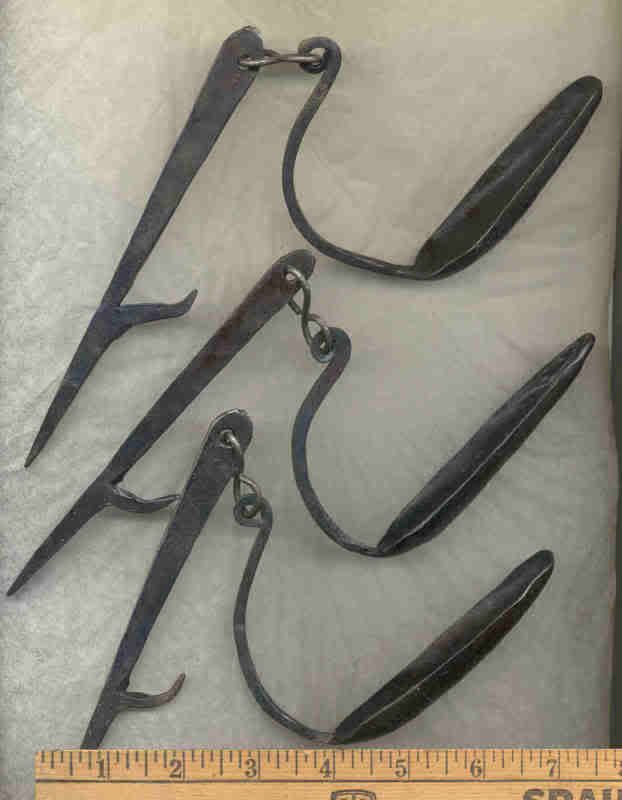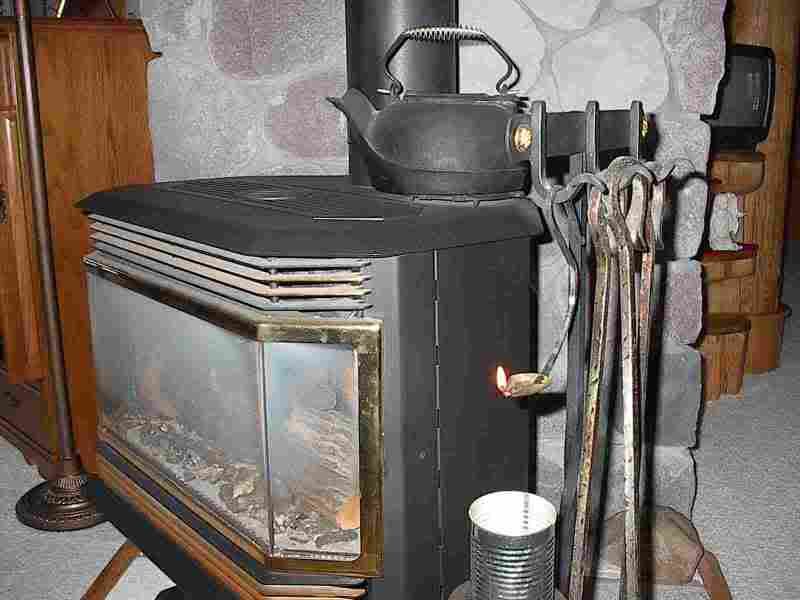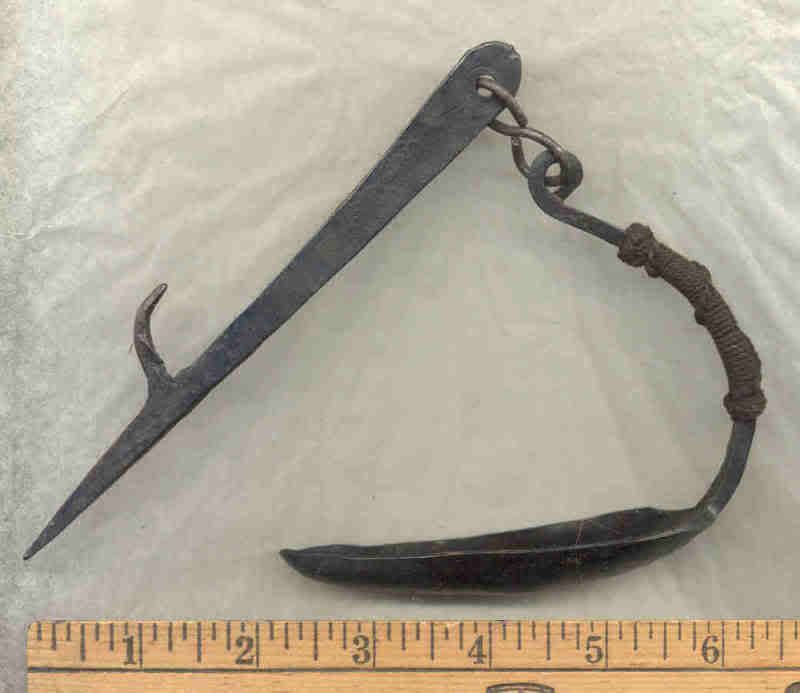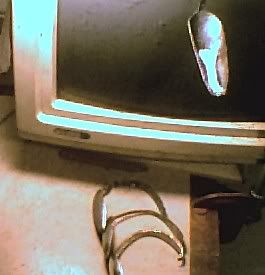Aaaah, more about grease lamps. (from a discussion on another MB)
Several people had doubts about using a kitchen serving spoon as a grease lamp. (I originally said a table spoon, but a serving spoon works better.) Well, today we had a little break in the cold weather, and I had some forging projects to catch up on. So I dug through my "junker" silverware box and came up with a half dozen serving spoons to play with. I hammer shaped several - to narrow out the "spout" end. But I also just took one as-is and just bent the handle up in a gentle arc to hang it. I did drill a hole through the end, put a twisted wire loop in it, and then hung it in my kitchen using some hemp twine. I hung it over my sink to catch "drips", and also hung one with a necked in spout next to it by a simple hemp twine. I then raided the (new) mop for some wick material, and used Crisco veg oil (I cleaned out the bacon grease drippings can last week). So the test was on. It took a full stick match to get each one lit - to heat up the oil enough to start vaporizing on the end of the wick. I did have a few ... drips. But the sink caught those. With each "bowl" of the spoon 3/4 full of veg oil, they both burned around 20 to 25 minutes with a light similar to a candle. I just topped both up without putting the flame out. But I did have to adjust the wick in one - pull a bit more up. The wick only burns above the oil level.
Simple observation: The regular unmodified spoon bowl worked as well as the one I modified by necking it down and pointing it.
So the only thing necessary for you to make your own grease lamp from a serving spoon is to gently curve that handle up and back over the bowl of the spoon. Then figure out how you want to hang it - either with a simple leather/hemp cord tied around it, or with a hole drilled/punched through and a wire loop in place. After you have your tie point established, then you can ... tweak ... the curve in the handle until the spoon bowl hangs level.
Here are a few (poor) pics of the grease lamps in use. (My digital camera is a junker "snapshot" one)
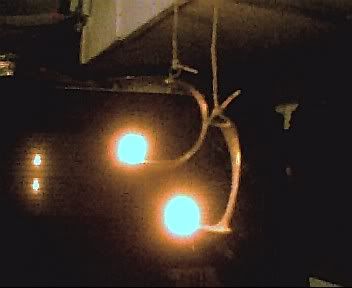
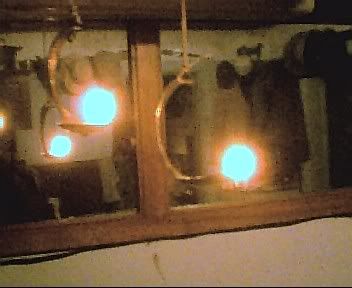
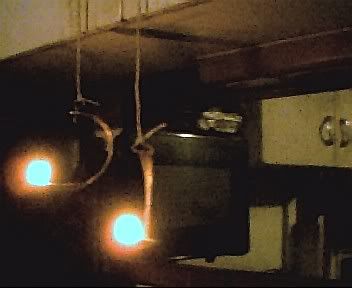
So a full forged grease lamp is nice, but you can make your own from a kitchen serving spoon. Just check the shape/style of it against the known patterns of silverware for your time period. A surprising number of those old patterns are still available.
I've got some documentation for these spoon conversions to use as a grease lamp here somewhere in these stacks of books. It's for the mid to late 1700's - possibly back into the 1600's. I'll see if I can find it in whatever book I saw it in.
And I disavow any knowledge or accountability if YOU get caught raiding the good silverware for this project. I was lucky to have a pretty good box full of "junker" silverware to dig through. The ... good stuff ... never got touched!!!! (and I get to live through another night)
Have fun.
Mikey - that grumpy ol' German blacksmith out in the Hinterlands
p.s. Yeah yeah, I know. Why should I be telling you how to do stuff for yourself that I could charge to have me do for you. Well, it's because I ain't trying to ... chase ... every possible buck. That's for REAL businessmen. So my friends who would point this out to me can save their breathe.
Several people had doubts about using a kitchen serving spoon as a grease lamp. (I originally said a table spoon, but a serving spoon works better.) Well, today we had a little break in the cold weather, and I had some forging projects to catch up on. So I dug through my "junker" silverware box and came up with a half dozen serving spoons to play with. I hammer shaped several - to narrow out the "spout" end. But I also just took one as-is and just bent the handle up in a gentle arc to hang it. I did drill a hole through the end, put a twisted wire loop in it, and then hung it in my kitchen using some hemp twine. I hung it over my sink to catch "drips", and also hung one with a necked in spout next to it by a simple hemp twine. I then raided the (new) mop for some wick material, and used Crisco veg oil (I cleaned out the bacon grease drippings can last week). So the test was on. It took a full stick match to get each one lit - to heat up the oil enough to start vaporizing on the end of the wick. I did have a few ... drips. But the sink caught those. With each "bowl" of the spoon 3/4 full of veg oil, they both burned around 20 to 25 minutes with a light similar to a candle. I just topped both up without putting the flame out. But I did have to adjust the wick in one - pull a bit more up. The wick only burns above the oil level.
Simple observation: The regular unmodified spoon bowl worked as well as the one I modified by necking it down and pointing it.
So the only thing necessary for you to make your own grease lamp from a serving spoon is to gently curve that handle up and back over the bowl of the spoon. Then figure out how you want to hang it - either with a simple leather/hemp cord tied around it, or with a hole drilled/punched through and a wire loop in place. After you have your tie point established, then you can ... tweak ... the curve in the handle until the spoon bowl hangs level.
Here are a few (poor) pics of the grease lamps in use. (My digital camera is a junker "snapshot" one)



So a full forged grease lamp is nice, but you can make your own from a kitchen serving spoon. Just check the shape/style of it against the known patterns of silverware for your time period. A surprising number of those old patterns are still available.
I've got some documentation for these spoon conversions to use as a grease lamp here somewhere in these stacks of books. It's for the mid to late 1700's - possibly back into the 1600's. I'll see if I can find it in whatever book I saw it in.
And I disavow any knowledge or accountability if YOU get caught raiding the good silverware for this project. I was lucky to have a pretty good box full of "junker" silverware to dig through. The ... good stuff ... never got touched!!!! (and I get to live through another night)
Have fun.
Mikey - that grumpy ol' German blacksmith out in the Hinterlands
p.s. Yeah yeah, I know. Why should I be telling you how to do stuff for yourself that I could charge to have me do for you. Well, it's because I ain't trying to ... chase ... every possible buck. That's for REAL businessmen. So my friends who would point this out to me can save their breathe.





